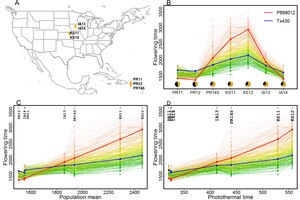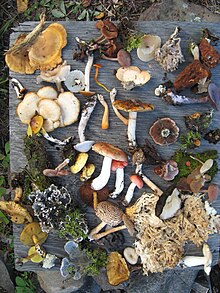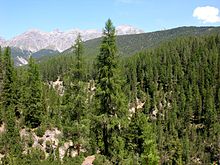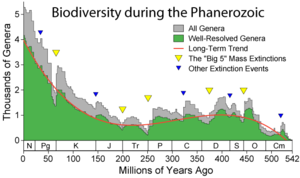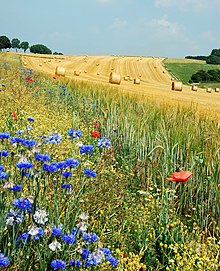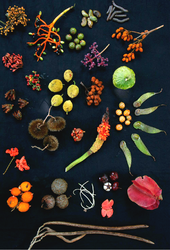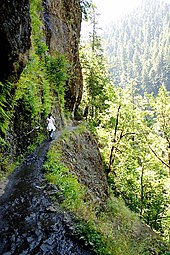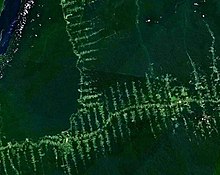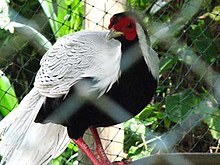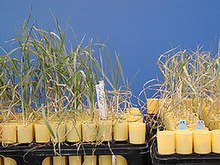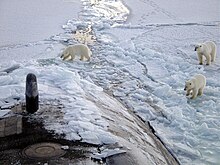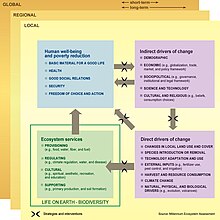From Wikipedia, the free encyclopedia
A sampling of fungi collected during summer 2008 in Northern Saskatchewan mixed woods, near LaRonge is an example regarding the species diversity of fungi. In this photo, there are also leaf lichens and mosses.
Rapid
environmental changes typically cause
mass extinctions. More than 99.9 percent of all species that ever lived on Earth, amounting to over five billion species, are estimated to be
extinct. Estimates on the number of Earth's current
species range from 10 million to 14 million, of which about 1.2 million have been documented and over 86 percent have not yet been described.
More recently, in May 2016, scientists reported that 1 trillion species
are estimated to be on Earth currently with only one-thousandth of one
percent described. The total amount of related
DNA base pairs on Earth is estimated at 5.0 x 10
37 and weighs 50 billion
tonnes. In comparison, the total
mass of the
biosphere has been estimated to be as much as 4
TtC (trillion tons of
carbon). In July 2016, scientists reported identifying a set of 355
genes from the
Last Universal Common Ancestor (LUCA) of all
organisms living on Earth.
The period since the emergence of
humans has displayed an ongoing biodiversity reduction and an accompanying loss of
genetic diversity. Named the
Holocene extinction, the reduction is caused primarily by
human impacts, particularly
habitat destruction. Conversely, biodiversity positively impacts
human health in a number of ways, although a few negative effects are studied.
History of terminology
- 1916 - The term biological diversity was used first by J. Arthur Harris in "The Variable Desert," Scientific American, JSTOR 6182:
"The bare statement that the region contains a flora rich in genera and
species and of diverse geographic origin or affinity is entirely
inadequate as a description of its real biological diversity."
- 1975 - The term natural diversity was introduced (by The Science Division of The Nature Conservancy in a 1975 study, "The Preservation of Natural Diversity.")
- 1980 - Thomas Lovejoy introduced the term biological diversity to the scientific community in a book. It rapidly became commonly used.
- 1985 - According to Edward O. Wilson, the contracted form biodiversity
was coined by W. G. Rosen: "The National Forum on BioDiversity ... was
conceived by Walter G.Rosen ... Dr. Rosen represented the NRC/NAS
throughout the planning stages of the project. Furthermore, he
introduced the term biodiversity".
- 1985 - The term "biodiversity" appears in the article, "A New Plan to Conserve the Earth's Biota" by Laura Tangley.
- 1988 - The term biodiversity first appeared in a publication.
- The present - the term has achieved widespread use.
Definitions
Prior term
Alternate terms
Biologists most often define biodiversity as the "totality of
genes,
species and
ecosystems of a region".
An advantage of this definition is that it seems to describe most
circumstances and presents a unified view of the traditional types of
biological variety previously identified:
- taxonomic diversity (usually measured at the species diversity level)
- ecological diversity (often viewed from the perspective of ecosystem diversity)
- morphological diversity (which stems from genetic diversity and molecular diversity)
- functional diversity
(which is a measure of the number of functionally disparate species
within a population (e.g. different feeding mechanism, different
motility, predator vs prey, etc.)) This multilevel construct is consistent with Datman and Lovejoy.
Wilcox 1982
An explicit definition consistent with this interpretation was first given in a paper by Bruce A. Wilcox commissioned by the
International Union for the Conservation of Nature and Natural Resources
(IUCN) for the 1982 World National Parks Conference. Wilcox's
definition was "Biological diversity is the variety of life forms...at
all levels of biological systems (i.e., molecular, organismic,
population, species and ecosystem)..."
Genetic: Wilcox 1984
Biodiversity can be defined genetically as the diversity of alleles, genes and
organisms. They study processes such as
mutation and
gene transfer that drive evolution.
United Nations 1992
Gaston and Spicer 2004
Gaston
& Spicer's definition in their book "Biodiversity: an introduction"
is "variation of life at all levels of biological organization".
Distribution
Terrestrial biodiversity is thought to be up to 25 times greater than ocean biodiversity.
A new method used in 2011, put the total number of species on Earth at
8.7 million, of which 2.1 million were estimated to live in the ocean. However, this estimate seems to under-represent the diversity of microorganisms.
Latitudinal gradients
Generally, there is an increase in biodiversity from the
poles to the
tropics. Thus localities at lower
latitudes
have more species than localities at higher latitudes. This is often
referred to as the latitudinal gradient in species diversity. Several
ecological factors may contribute to the gradient, but the ultimate
factor behind many of them is the greater mean temperature at the
equator compared to that of the poles.
Even though terrestrial biodiversity declines from the equator to the poles, some studies claim that this characteristic is unverified in
aquatic ecosystems, especially in
marine ecosystems. The latitudinal distribution of parasites does not appear to follow this rule.
In 2016, an alternative hypothesis ("the
fractal biodiversity") was proposed to explain the biodiversity latitudinal gradient. In this study, the
species
pool size and the fractal nature of ecosystems were combined to clarify
some general patterns of this gradient. This hypothesis considers
temperature,
moisture, and
net primary production (NPP) as the main variables of an ecosystem niche and as the axis of the ecological
hypervolume. In this way, it is possible to build fractal hypervolumes, whose
fractal dimension rises up to three moving towards the
equator.
Hotspots
Brazil's
Atlantic Forest
is considered one such hotspot, containing roughly 20,000 plant
species, 1,350 vertebrates and millions of insects, about half of which
occur nowhere else. The island of
Madagascar and
India are also particularly notable.
Colombia
is characterized by high biodiversity, with the highest rate of species
by area unit worldwide and it has the largest number of endemics
(species that are not found naturally anywhere else) of any country.
About 10% of the species of the Earth can be found in Colombia,
including over 1,900 species of bird, more than in Europe and North
America combined, Colombia has 10% of the world's mammals species, 14%
of the amphibian species and 18% of the bird species of the world.
Madagascar dry deciduous forests and lowland rainforests possess a high ratio of
endemism. Since the island separated from mainland
Africa 66 million years ago, many species and ecosystems have evolved independently.
Indonesia's 17,000 islands cover 735,355 square miles (1,904,560 km
2) and contain 10% of the world's
flowering plants, 12% of mammals and 17% of
reptiles,
amphibians and
birds—along with nearly 240 million people. Many regions of high biodiversity and/or endemism arise from specialized
habitats which require unusual adaptations, for example,
alpine environments in high
mountains, or
Northern European peat
bogs.
Accurately measuring differences in biodiversity can be difficult.
Selection bias amongst researchers may contribute to biased empirical research for modern estimates of biodiversity. In 1768, Rev.
Gilbert White succinctly observed of his
Selborne, Hampshire "all nature is so full, that that district produces the most variety which is the most examined."
Evolution
Apparent marine fossil diversity during the Phanerozoic
Chronology
The history of biodiversity during the
Phanerozoic (the last 540 million years), starts with rapid growth during the
Cambrian explosion—a period during which nearly every
phylum of
multicellular organisms
first appeared. Over the next 400 million years or so, invertebrate
diversity showed little overall trend and vertebrate diversity shows an
overall exponential trend. This dramatic rise in diversity was marked by periodic, massive losses of diversity classified as
mass extinction events. A significant loss occurred when rainforests collapsed in the carboniferous. The worst was the
Permian-Triassic extinction event, 251 million years ago. Vertebrates took 30 million years to recover from this event.
The
fossil record suggests that the last few million years featured the greatest biodiversity in
history.
However, not all scientists support this view, since there is
uncertainty as to how strongly the fossil record is biased by the
greater availability and preservation of recent
geologic
sections. Some scientists believe that corrected for sampling
artifacts, modern biodiversity may not be much different from
biodiversity 300 million years ago, whereas others consider the fossil record reasonably reflective of the diversification of life.
Estimates of the present global macroscopic species diversity vary from
2 million to 100 million, with a best estimate of somewhere near 9
million, the vast majority
arthropods. Diversity appears to increase continually in the absence of natural selection.
Diversification
The existence of a
global carrying capacity,
limiting the amount of life that can live at once, is debated, as is
the question of whether such a limit would also cap the number of
species. While records of life in the sea shows a
logistic pattern of growth, life on land (insects, plants and tetrapods) shows an
exponential
rise in diversity. As one author states, "Tetrapods have not yet
invaded 64 per cent of potentially habitable modes and it could be that
without human influence the ecological and
taxonomic
diversity of tetrapods would continue to increase in an exponential
fashion until most or all of the available ecospace is filled."
It also appears that the diversity continue to increase over time, especially after mass extinctions.
On the other hand, changes through the
Phanerozoic correlate much better with the
hyperbolic model (widely used in
population biology,
demography and
macrosociology, as well as
fossil
biodiversity) than with exponential and logistic models. The latter
models imply that changes in diversity are guided by a first-order
positive feedback (more ancestors, more descendants) and/or a
negative feedback arising from resource limitation. Hyperbolic model implies a second-order positive feedback. The hyperbolic pattern of the
world population growth arises from a second-order positive feedback between the population size and the rate of technological growth.
The hyperbolic character of biodiversity growth can be similarly
accounted for by a feedback between diversity and community structure
complexity. The similarity between the curves of biodiversity and human
population probably comes from the fact that both are derived from the
interference of the hyperbolic trend with cyclical and
stochastic dynamics.
Most biologists agree however that the period since human emergence is part of a new mass extinction, named the
Holocene extinction event, caused primarily by the impact humans are having on the environment.
It has been argued that the present rate of extinction is sufficient to
eliminate most species on the planet Earth within 100 years.
In 2011, in his
Biodiversity-related Niches Differentiation Theory,
Roberto Cazzolla Gatti
proposed that species themselves are the architects of biodiversity, by
proportionally increasing the number of potentially available niches in
a given ecosystem. This study led to the idea that biodiversity is
autocatalytic. An
ecosystem of interdependent
species can be, therefore, considered as an
emergent autocatalytic set (a self-sustaining network of mutually "
catalytic"
entities), where one (group of) species enables the existence of (i.e.,
creates niches for) other species. This view offers a possible answer
to the fundamental question of why so many species can
coexist in the same ecosystem.
New species are regularly discovered (on average between 5–10,000 new species each year, most of them
insects) and many, though discovered, are not yet classified (estimates are that nearly 90% of all
arthropods are not yet classified). Most of the terrestrial diversity is found in
tropical forests
and in general, land has more species than the ocean; some 8.7 million
species may exists on Earth, of which some 2.1 million live in the
ocean.
Ecosystem services
The balance of evidence
"Ecosystem services are the suite of benefits that ecosystems provide to humanity."
The natural species, or biota, are the caretakers of all ecosystems. It
is as if the natural world is an enormous bank account of capital
assets capable of paying life sustaining dividends indefinitely, but
only if the capital is maintained.
These services come in three flavors:
- Provisioning services which involve the production of renewable resources (e.g.: food, wood, fresh water)
- Regulating services which are those that lessen environmental change (e.g.: climate regulation, pest/disease control)
- Cultural services represent human value and enjoyment (e.g.:
landscape aesthetics, cultural heritage, outdoor recreation and
spiritual significance)
There have been many claims about biodiversity's effect on these
ecosystem services, especially provisioning and regulating services.
After an exhaustive survey through peer-reviewed literature to evaluate
36 different claims about biodiversity's effect on ecosystem services,
14 of those claims have been validated, 6 demonstrate mixed support or
are unsupported, 3 are incorrect and 13 lack enough evidence to draw
definitive conclusions.
Services enhanced
Provisioning services
Greater species diversity
- of plants increases fodder yield (synthesis of 271 experimental studies).
- of plants (i.e. diversity within a single species) increases overall crop yield (synthesis of 575 experimental studies). Although another review of 100 experimental studies reports mixed evidence.
- of trees increases overall wood production (Synthesis of 53 experimental studies). However, there is not enough data to draw a conclusion about the effect of tree trait diversity on wood production.
Regulating services
Greater species diversity
- of fish increases the stability of fisheries yield (Synthesis of 8 observational studies)
- of natural pest enemies decreases herbivorous pest populations (Data
from two separate reviews; Synthesis of 266 experimental and
observational studies; Synthesis of 18 observational studies.
Although another review of 38 experimental studies found mixed support
for this claim, suggesting that in cases where mutual intraguild
predation occurs, a single predatory species is often more effective
- of plants decreases disease prevalence on plants (Synthesis of 107 experimental studies)
- of plants increases resistance to plant invasion (Data from two separate reviews; Synthesis of 105 experimental studies; Synthesis of 15 experimental studies)
- of plants increases carbon sequestration, but note that this finding
only relates to actual uptake of carbon dioxide and not long term
storage, see below; Synthesis of 479 experimental studies)
- plants increases soil nutrient remineralization (Synthesis of 103 experimental studies)
- of plants increases soil organic matter (Synthesis of 85 experimental studies)
Services with mixed evidence
Provisioning services
Regulating services
- Greater
species diversity of plants may or may not decrease herbivorous pest
populations. Data from two separate reviews suggest that greater
diversity decreases pest populations (Synthesis of 40 observational
studies; Synthesis of 100 experimental studies). One review found mixed evidence (Synthesis of 287 experimental studies), while another found contrary evidence (Synthesis of 100 experimental studies)
- Greater species diversity of animals may or may not decrease disease
prevalence on those animals (Synthesis of 45 experimental and
observational studies),
although a 2013 study offers more support showing that biodiversity may
in fact enhance disease resistance within animal communities, at least
in amphibian frog ponds.
Many more studies must be published in support of diversity to sway the
balance of evidence will be such that we can draw a general rule on
this service.
- Greater species and trait diversity of plants may or may not
increase long term carbon storage (Synthesis of 33 observational
studies)
- Greater pollinator diversity may or may not increase pollination (Synthesis of 7 observational studies),
but a publication from March 2013 suggests that increased native
pollinator diversity enhances pollen deposition (although not
necessarily fruit set as the authors would have you believe, for details
explore their lengthy supplementary material).
Services hindered
Provisioning services
- Greater species diversity of plants reduces primary production (Synthesis of 7 experimental studies)
Regulating services
- greater
genetic and species diversity of a number of organisms reduces
freshwater purification (Synthesis of 8 experimental studies, although
an attempt by the authors to investigate the effect of detritivore
diversity on freshwater purification was unsuccessful due to a lack of
available evidence (only 1 observational study was found
Provisioning services
- Effect of species diversity of plants on biofuel yield (In a survey of the literature, the investigators only found 3 studies)
- Effect of species diversity of fish on fishery yield (In a survey of
the literature, the investigators only found 4 experimental studies and
1 observational study)
Regulating services
- Effect of species diversity on the stability of biofuel yield (In a survey of the literature, the investigators did not find any studies)
- Effect of species diversity of plants on the stability of fodder
yield (In a survey of the literature, the investigators only found 2
studies)
- Effect of species diversity of plants on the stability of crop yield
(In a survey of the literature, the investigators only found 1 study)
- Effect of genetic diversity of plants on the stability of crop yield (In a survey of the literature, the investigators only found 2 studies)
- Effect of diversity on the stability of wood production (In a survey
of the literature, the investigators could not find any studies)
- Effect of species diversity of multiple taxa on erosion control
(In a survey of the literature, the investigators could not find any
studies – they did however find studies on the effect of species
diversity and root biomass)
- Effect of diversity on flood regulation (In a survey of the literature, the investigators could not find any studies)
- Effect of species and trait diversity of plants on soil moisture (In a survey of the literature, the investigators only found 2 studies)
Other sources have reported somewhat conflicting results and in 1997
Robert Costanza and his colleagues reported the estimated global value
of ecosystem services (not captured in traditional markets) at an
average of $33 trillion annually.
Since the
stone age,
species loss has accelerated above the average basal rate, driven by
human activity. Estimates of species losses are at a rate 100-10,000
times as fast as is typical in the fossil record.
Biodiversity also affords many non-material benefits including spiritual and aesthetic values, knowledge systems and education.
Agriculture
Agricultural diversity can be divided into two categories:
intraspecific diversity, which includes the genetic variety within a single species, like the potato (
Solanum tuberosum)
that is composed of many different forms and types (e.g. in the U.S.
they might compare russet potatoes with new potatoes or purple potatoes,
all different, but all part of the same species,
S. tuberosum).
The other category of agricultural diversity is called
interspecific diversity
and refers to the number and types of different species. Thinking about
this diversity we might note that many small vegetable farmers grow
many different crops like potatoes and also carrots, peppers, lettuce
etc.
Agricultural diversity can also be divided by whether it is
‘planned’ diversity or ‘associated’ diversity. This is a functional
classification that we impose and not an intrinsic feature of life or
diversity. Planned diversity includes the crops which a farmer has
encouraged, planted or raised (e.g. crops, covers, symbionts and
livestock, among others), which can be contrasted with the associated
diversity that arrives among the crops, uninvited (e.g. herbivores, weed
species and pathogens, among others).
The control of associated biodiversity is one of the great agricultural challenges that farmers face. On
monoculture farms, the approach is generally to eradicate associated diversity using a suite of biologically destructive
pesticides, mechanized tools and
transgenic engineering techniques, then to
rotate crops. Although some
polyculture farmers use the same techniques, they also employ
integrated pest management
strategies as well as strategies that are more labor-intensive, but
generally less dependent on capital, biotechnology and energy.
Interspecific crop diversity is, in part, responsible for
offering variety in what we eat. Intraspecific diversity, the variety of
alleles within a single species, also offers us choice in our diets. If
a crop fails in a monoculture, we rely on agricultural diversity to
replant the land with something new. If a wheat crop is destroyed by a
pest we may plant a hardier variety of wheat the next year, relying on
intraspecific diversity. We may forgo wheat production in that area and
plant a different species altogether, relying on interspecific
diversity. Even an agricultural society which primarily grows
monocultures, relies on biodiversity at some point.
- The Irish potato blight
of 1846 was a major factor in the deaths of one million people and the
emigration of about two million. It was the result of planting only two
potato varieties, both vulnerable to the blight, Phytophthora infestans, which arrived in 1845
- When rice grassy stunt virus struck rice fields from Indonesia to India in the 1970s, 6,273 varieties were tested for resistance. Only one was resistant, an Indian variety and known to science only since 1966. This variety formed a hybrid with other varieties and is now widely grown.
- Coffee rust attacked coffee plantations in Sri Lanka, Brazil and Central America in 1970. A resistant variety was found in Ethiopia. The diseases are themselves a form of biodiversity.
Monoculture
was a contributing factor to several agricultural disasters, including
the European wine industry collapse in the late 19th century and the US
southern corn leaf blight epidemic of 1970.
Although about 80 percent of humans' food supply comes from just 20 kinds of plants, humans use at least 40,000 species. Many people depend on these species for food, shelter and clothing.
Earth's surviving biodiversity provides resources for increasing the
range of food and other products suitable for human use, although the
present extinction rate shrinks that potential.
Human health
Biodiversity's relevance to human health is becoming an international
political issue, as scientific evidence builds on the global health
implications of biodiversity loss. This issue is closely linked with the issue of
climate change, as many of the anticipated health risks of
climate change
are associated with changes in biodiversity (e.g. changes in
populations and distribution of disease vectors, scarcity of fresh
water, impacts on agricultural biodiversity and food resources etc.).
This is because the species most likely to disappear are those that
buffer against infectious disease transmission, while surviving species
tend to be the ones that increase disease transmission, such as that of
West Nile Virus, Lyme disease and Hantavirus, according to a study done
co-authored by Felicia Keesing, an ecologist at Bard College and Drew
Harvell, associate director for Environment of the
Atkinson Center for a Sustainable Future (ACSF) at
Cornell University.
The growing demand and lack of drinkable water on the planet
presents an additional challenge to the future of human health. Partly,
the problem lies in the success of water suppliers to increase supplies
and failure of groups promoting preservation of water resources.
While the distribution of clean water increases, in some parts of the
world it remains unequal. According to the World Health Organisation
(2018) only 71% of the global population used a safely managed
drinking-water service.
Some of the health issues influenced by biodiversity include
dietary health and nutrition security, infectious disease, medical
science and medicinal resources, social and psychological health.
Biodiversity is also known to have an important role in reducing
disaster risk and in post-disaster relief and recovery efforts.
Biodiversity provides critical support for drug discovery and the availability of medicinal resources.
A significant proportion of drugs are derived, directly or indirectly,
from biological sources: at least 50% of the pharmaceutical compounds on
the US market are derived from plants, animals and
micro-organisms,
while about 80% of the world population depends on medicines from
nature (used in either modern or traditional medical practice) for
primary healthcare.
Only a tiny fraction of wild species has been investigated for medical
potential. Biodiversity has been critical to advances throughout the
field of
bionics.
Evidence from market analysis and biodiversity science indicates that
the decline in output from the pharmaceutical sector since the mid-1980s
can be attributed to a move away from natural product exploration
("bioprospecting") in favor of genomics and synthetic chemistry, indeed
claims about the value of undiscovered pharmaceuticals may not provide
enough incentive for companies in free markets to search for them
because of the high cost of development; meanwhile, natural products have a long history of supporting significant economic and health innovation. Marine ecosystems are particularly important, although inappropriate
bioprospecting can increase biodiversity loss, as well as violating the laws of the communities and states from which the resources are taken.
Business and industry
Many industrial materials derive directly from biological sources.
These include building materials, fibers, dyes, rubber and oil.
Biodiversity is also important to the security of resources such as
water, timber, paper, fiber and food.
As a result, biodiversity loss is a significant risk factor in business
development and a threat to long term economic sustainability.
Leisure, cultural and aesthetic value
Biodiversity enriches leisure activities such as
hiking,
birdwatching or natural history study. Biodiversity inspires
musicians, painters,
sculptors,
writers and other artists. Many cultures view themselves as an integral
part of the natural world which requires them to respect other living
organisms.
Popular activities such as
gardening,
fishkeeping
and specimen collecting strongly depend on biodiversity. The number of
species involved in such pursuits is in the tens of thousands, though
the majority do not enter commerce.
The relationships between the original natural areas of these
often exotic animals and plants and commercial collectors, suppliers,
breeders, propagators and those who promote their understanding and
enjoyment are complex and poorly understood. The general public responds
well to exposure to rare and unusual organisms, reflecting their
inherent value.
Philosophically it could be argued that biodiversity has intrinsic aesthetic and spiritual value to
mankind in and of itself. This idea can be used as a counterweight to the notion that
tropical forests and other ecological realms are only worthy of conservation because of the services they provide.
Ecological services
"There is now unequivocal evidence that biodiversity loss
reduces the efficiency by which ecological communities capture
biologically essential resources, produce biomass, decompose and recycle
biologically essential nutrients... There is mounting evidence that
biodiversity increases the stability of ecosystem functions through
time... Diverse communities are more productive because they contain key
species that have a large influence on productivity and differences in
functional traits among organisms increase total resource capture... The
impacts of diversity loss on ecological processes might be sufficiently
large to rival the impacts of many other global drivers of
environmental change... Maintaining multiple ecosystem processes at
multiple places and times requires higher levels of biodiversity than
does a single process at a single place and time."
It plays a part in regulating the chemistry of our
atmosphere and
water supply. Biodiversity is directly involved in
water purification, recycling
nutrients
and providing fertile soils. Experiments with controlled environments
have shown that humans cannot easily build ecosystems to support human
needs; for example
insect pollination cannot be mimicked, though there have been attempts to create artificial pollinators using
unmanned aerial vehicles. The economic activity of pollination alone represented between $2.1-14.6 billions in 2003.
Number of species
Discovered and predicted total number of species on land and in the oceans
According to Mora and colleagues, the total number of terrestrial
species is estimated to be around 8.7 million while the number of
oceanic species is much lower, estimated at 2.2 million. The authors
note that these estimates are strongest for eukaryotic organisms and
likely represent the lower bound of prokaryote diversity. Other estimates include:
- 220,000 vascular plants, estimated using the species-area relation method
- 0.7-1 million marine species
- 10–30 million insects; (of some 0.9 million we know today)
- 5–10 million bacteria;
- 1.5-3 million fungi, estimates based on data from the tropics, long-term non-tropical sites and molecular studies that have revealed cryptic speciation. Some 0.075 million species of fungi had been documented by 2001)
- 1 million mites
- The number of microbial species is not reliably known, but the Global Ocean Sampling Expedition dramatically increased the estimates of genetic diversity by identifying an enormous number of new genes from near-surface plankton samples at various marine locations, initially over the 2004-2006 period. The findings may eventually cause a significant change in the way science defines species and other taxonomic categories.
Since the rate of extinction has increased, many extant species may become extinct before they are described. Not surprisingly, in the
animalia the most studied groups are
birds and
mammals, whereas
fishes and
arthropods are the least studied
animals groups.
Measuring biodiversity
Species loss rates
No longer do we have to justify the
existence of humid tropical forests on the feeble grounds that they
might carry plants with drugs that cure human disease. Gaia theory
forces us to see that they offer much more than this. Through their
capacity to evapotranspirate vast volumes of water vapor, they serve to
keep the planet cool by wearing a sunshade of white reflecting cloud.
Their replacement by cropland could precipitate a disaster that is
global in scale.
During the last century, decreases in biodiversity have been
increasingly observed. In 2007, German Federal Environment Minister
Sigmar Gabriel cited estimates that up to 30% of all species will be extinct by 2050. Of these, about one eighth of known plant species are threatened with
extinction. Estimates reach as high as 140,000 species per year (based on
Species-area theory). This figure indicates
unsustainable ecological practices, because few species emerge each year.
Almost all scientists acknowledge that the rate of species loss is
greater now than at any time in human history, with extinctions
occurring at rates hundreds of times higher than
background extinction rates. As of 2012, some studies suggest that 25% of all mammal species could be extinct in 20 years.
In absolute terms, the planet has lost 58% of its biodiversity since 1970 according to a 2016 study by the
World Wildlife Fund.
The Living Planet Report 2014 claims that "the number of mammals,
birds, reptiles, amphibians and fish across the globe is, on average,
about half the size it was 40 years ago". Of that number, 39% accounts
for the terrestrial wildlife gone, 39% for the marine wildlife gone and
76% for the freshwater wildlife gone. Biodiversity took the biggest hit
in
Latin America,
plummeting 83 percent. High-income countries showed a 10% increase in
biodiversity, which was canceled out by a loss in low-income countries.
This is despite the fact that high-income countries use five times the
ecological resources of low-income countries, which was explained as a
result of process whereby wealthy nations are outsourcing
resource depletion to poorer nations, which are suffering the greatest ecosystem losses.
A 2017 study published in
PLOS One found that the biomass of insect life in Germany had declined by three-quarters in the last 25 years. Dave Goulson of
Sussex University
stated that their study suggested that humans "appear to be making vast
tracts of land inhospitable to most forms of life, and are currently on
course for ecological Armageddon. If we lose the insects then
everything is going to collapse."
Threats
In 2006, many species were formally classified as
rare or
endangered or
threatened;
moreover, scientists have estimated that millions more species are at
risk which have not been formally recognized. About 40 percent of the
40,177 species assessed using the
IUCN Red List criteria are now listed as threatened with
extinction—a total of 16,119.
The 11 main direct threats to conservation are:
1. residential & commercial development
- housing & urban areas (urban areas, suburbs, villages, vacation homes, shopping areas, offices, schools, hospitals)
- commercial & industrial areas (manufacturing plants, shopping centers, office parks, military bases, power plants, train & ship yards, airports)
- tourism & recreational areas (skiing, golf courses, sports fields, parks, campgrounds)
2. farming activities
- agriculture (crop farms, orchards, vineyards, plantations, ranches)
- aquaculture (shrimp or fin fish aquaculture, fish ponds on farms, hatchery salmon, seeded shellfish beds, artificial algal beds)
3. energy production & mining
- renewable energy production (geothermal, solar, wind, & tidal farms)
- non-renewable energy production (oil and gas drilling)
- mining (fuel and minerals)
4. transportation & service corridors
- service corridors (electrical & phone wires, aqueducts, oil & gas pipelines)
- transport corridors (roads, railroads, shipping lanes, and flight paths)
- collisions with the vehicles using the corridors
- associated accidents and catastrophes (oil spills, electrocution, fire)
5. biological resource usages
- hunting (bushmeat, trophy, fur)
- persecution (predator control and pest control, superstitions)
- plant destruction or removal (human consumption, free range livestock foraging, battling timber disease, orchid collection)
- logging or wood harvesting (selective or clear cutting, firewood collection, charcoal production)
- fishing (trawling, whaling, live coral or seaweed or egg collection)
6. human intrusions & activities that alter, destroy, simply disturb habitats and species from exhibiting natural behaviors
- recreational activities (off-road vehicles,
motorboats, jet-skis, snowmobiles, ultralight planes, dive boats, whale
watching, mountain bikes, hikers, birdwatchers, skiers, pets in
recreational areas, temporary campsites, caving, rock-climbing)
- war, civil unrest, & military exercises (armed conflict, mine
fields, tanks & other military vehicles, training exercises &
ranges, defoliation, munitions testing)
- illegal activities (smuggling, immigration, vandalism)
7. natural system modifications
- fire suppression or creation (controlled burns, inappropriate fire management, escaped agricultural and campfires, arson)
- water management (dam construction & operation, wetland filling, surface water diversion, groundwater pumping)
- other modifications (reclamation projects, shoreline rip-rap, lawn cultivation, beach construction and maintenance, tree-thinning in parks)
- removing/reducing human maintenance (mowing meadows, reduction in
controlled burns, lack of indigenous management of key ecosystems,
ceasing supplemental feeding of condors)
8. invasive & problematic species, pathogens & genes
- invasive species (feral horses & household pets, zebra mussels, Miconia tree, kudzu, introduction for biocontrol)
- problematic native species (overabundant native deer or kangaroo, overabundant algae due to loss of native grazing fish, locust-type plagues)
- introduced genetic material (pesticide-resistant crops,
genetically modified insects for biocontrol, genetically modified trees
or salmon, escaped hatchery salmon, restoration projects using non-local
seed stock)
- pathogens & microbes (plague affecting rodents or rabbits,
Dutch elm disease or chestnut blight, Chytrid fungus affecting
amphibians outside of Africa)
9. pollution
- household sewage & urban waste water (discharge
from municipal waste treatment plants, leaking septic systems, untreated
sewage, outhouses, oil or sediment from roads, fertilizers and
pesticides from lawns and golf-courses, road salt)
- industrial & military effluents (toxic chemicals from
factories, illegal dumping of chemicals, mine tailings, arsenic from
gold mining, leakage from fuel tanks, PCBs in river sediments)
- agricultural & forestry effluents (nutrient loading from fertilizer run-off, herbicide run-off, manure from feedlots, nutrients from aquaculture, soil erosion)
- garbage & solid waste (municipal waste, litter & dumped
possessions, flotsam & jetsam from recreational boats, waste that
entangles wildlife, construction debris)
- air-borne pollutants (acid rain, smog from vehicle emissions,
excess nitrogen deposition, radioactive fallout, wind dispersion of
pollutants or sediments from farm fields, smoke from forest fires or
wood stoves)
- excess energy (noise from highways or airplanes, sonar from
submarines that disturbs whales, heated water from power plants, lamps
attracting insects, beach lights disorienting turtles, atmospheric
radiation from ozone holes)
10. catastrophic geological events
- earthquakes, tsunamis, avalanches, landslides, & volcanic eruptions and gas emissions
11. climate changes
- ecosystem encroachment (inundation of shoreline
ecosystems & drowning of coral reefs from sea level rise, sand dune
encroachment from desertification)
- changes in geochemical regimes (ocean acidification, changes in atmospheric CO2 affecting plant growth, loss of sediment leading to broad-scale subsidence)
- changes in temperature regimes (heat waves, cold spells, oceanic temperature changes, melting of glaciers/sea ice)
- changes in precipitation & hydrological regimes (droughts, rain timing, loss of snowcover, increased severity of floods)
- severe weather events (thunderstorms, tropical storms,
hurricanes, cyclones, tornadoes, hailstorms, ice storms or blizzards,
dust storms, erosion of beaches during storms)
Habitat destruction
Deforestation and increased road-building in the Amazon Rainforest
cause significant concern because of increased human encroachment upon
wild areas, increased resource extraction and further threats to
biodiversity.
Habitat size and numbers of species are systematically related.
Physically larger species and those living at lower latitudes or in
forests or oceans are more sensitive to reduction in habitat area. Conversion to "trivial" standardized ecosystems (e.g.,
monoculture following
deforestation)
effectively destroys habitat for the more diverse species that preceded
the conversion. Even the simplest forms of agriculture affect diversity
– through clearing/draining land, discouraging weeds and "pests", and
encouraging just a limited set of domesticated plant and animal species.
In some countries lack of property rights or lax law/regulatory
enforcement necessarily leads to biodiversity loss (degradation costs
having to be supported by the community).
Co-extinctions are a form of
habitat destruction.
Co-extinction occurs when the extinction or decline in one species
accompanies similar processes in another, such as in plants and beetles.
A 2019 report has revealed that bees and other pollinating
insects have been wiped out of almost a quarter of their habitats across
the United Kingdom. The population crashes have been happening since
1980s and are affecting the biodiversity. The increase in industrial
farming and pesticide use, combined with disease, invasive species and
climate change is threatening the future of these insects and the
agriculture they support.
Introduced and invasive species
Barriers such as large
rivers,
seas,
oceans,
mountains and
deserts encourage diversity by enabling independent evolution on either side of the barrier, via the process of
allopatric speciation. The term
invasive species
is applied to species that breach the natural barriers that would
normally keep them constrained. Without barriers, such species occupy
new territory, often supplanting native species by occupying their
niches, or by using resources that would normally sustain native
species.
The number of species invasions has been on the rise at least
since the beginning of the 1900s. Species are increasingly being moved
by humans (on purpose and accidentally). In some cases the invaders are
causing drastic changes and damage to their new habitats (e.g.: zebra
mussels and the emerald ash borer in the Great Lakes region and the lion
fish along the North American Atlantic coast). Some evidence suggests
that invasive species are competitive in their new habitats because they
are subject to less pathogen disturbance.
Others report confounding evidence that occasionally suggest that
species-rich communities harbor many native and exotic species
simultaneously while some say that diverse ecosystems are more resilient and resist invasive plants and animals. An important question is, "do invasive species cause extinctions?" Many studies cite effects of invasive species on natives, but not extinctions. Invasive species seem to increase local (i.e.:
alpha diversity) diversity, which decreases turnover of diversity (i.e.:
beta diversity). Overall
gamma diversity may be lowered because species are going extinct because of other causes,
but even some of the most insidious invaders (e.g.: Dutch elm disease,
emerald ash borer, chestnut blight in North America) have not caused
their host species to become extinct.
Extirpation,
population decline and
homogenization
of regional biodiversity are much more common. Human activities have
frequently been the cause of invasive species circumventing their
barriers,
by introducing them for food and other purposes. Human activities
therefore allow species to migrate to new areas (and thus become
invasive) occurred on time scales much shorter than historically have
been required for a species to extend its range.
Not all introduced species are invasive, nor all invasive species deliberately introduced. In cases such as the
zebra mussel,
invasion of US waterways was unintentional. In other cases, such as
mongooses in
Hawaii, the introduction is deliberate but ineffective (
nocturnal rats were not vulnerable to the
diurnal mongoose). In other cases, such as
oil palms in Indonesia and Malaysia, the introduction produces substantial economic benefits, but the benefits are accompanied by costly
unintended consequences.
Finally, an introduced species may unintentionally injure a species that depends on the species it replaces. In
Belgium,
Prunus spinosa from Eastern Europe leafs much sooner than its West European counterparts, disrupting the feeding habits of the
Thecla betulae
butterfly (which feeds on the leaves). Introducing new species often
leaves endemic and other local species unable to compete with the exotic
species and unable to survive. The exotic organisms may be
predators,
parasites, or may simply outcompete indigenous species for nutrients, water and light.
At present, several countries have already imported so many
exotic species, particularly agricultural and ornamental plants, that
their own indigenous fauna/flora may be outnumbered. For example, the
introduction of
kudzu from Southeast Asia to Canada and the United States has threatened biodiversity in certain areas.
Genetic pollution
Endemic species can be threatened with
extinction through the process of
genetic pollution, i.e. uncontrolled
hybridization,
introgression and genetic swamping. Genetic pollution leads to homogenization or replacement of local
genomes as a result of either a numerical and/or
fitness advantage of an introduced species.
Hybridization and introgression are side-effects of introduction and invasion. These phenomena can be especially detrimental to
rare species that come into contact with more abundant ones. The abundant species can interbreed with the rare species, swamping its
gene pool. This problem is not always apparent from
morphological (outward appearance) observations alone. Some degree of
gene flow is normal adaptation and not all
gene and
genotype
constellations can be preserved. However, hybridization with or without
introgression may, nevertheless, threaten a rare species' existence.
Overexploitation
About 25% of world
fisheries are now overfished to the point where their current biomass is less than the level that maximizes their sustainable yield.
Hybridization, genetic pollution/erosion and food security
The Yecoro wheat (right) cultivar
is sensitive to salinity, plants resulting from a hybrid cross with
cultivar W4910 (left) show greater tolerance to high salinity
In
agriculture and
animal husbandry, the
Green Revolution popularized the use of conventional
hybridization
to increase yield. Often hybridized breeds originated in developed
countries and were further hybridized with local varieties in the
developing world to create high yield strains resistant to local climate
and diseases. Local governments and industry have been pushing
hybridization. Formerly huge gene pools of various wild and indigenous
breeds have collapsed causing widespread
genetic erosion and genetic pollution. This has resulted in loss of genetic diversity and biodiversity as a whole.
Genetic erosion and genetic pollution have the potential to destroy unique
genotypes, threatening future access to
food security.
A decrease in genetic diversity weakens the ability of crops and
livestock to be hybridized to resist disease and survive changes in
climate.
Climate change
Global warming is also considered to be a major potential threat to global biodiversity in the future.
For example, coral reefs – which are biodiversity hotspots – will be
lost within the century if global warming continues at the current
trend.
Climate change has seen many claims about potential to affect
biodiversity but evidence supporting the statement is tenuous.
Increasing atmospheric carbon dioxide certainly affects plant morphology and is acidifying oceans, and temperature affects species ranges, phenology, and weather, but the major impacts that have been predicted are still just potential impacts. We have not documented major extinctions yet, even as climate change drastically alters the biology of many species.
In 2004, an international collaborative study on four continents
estimated that 10 percent of species would become extinct by 2050
because of global warming. "We need to limit climate change or we wind
up with a lot of species in trouble, possibly extinct," said Dr. Lee
Hannah, a co-author of the paper and chief climate change biologist at
the Center for Applied Biodiversity Science at Conservation
International.
A recent study predicts that up to 35% of the world terrestrial
carnivores and ungulates will be at higher risk of extinction by 2050
because of the joint effects of predicted climate and land-use change
under business-as-usual human development scenarios.
Human overpopulation
The world's population numbered nearly 7.6 billion as of mid-2017
(which is approximately one billion more inhabitants compared to 2005)
and is forecast to reach 11.1 billion in 2100. Sir
David King, former chief scientific adviser to the UK government, told a parliamentary inquiry:
"It is self-evident that the massive growth in the human population through the 20th century has had more impact on biodiversity than any other single factor."
At least until the middle of the 21st century, worldwide losses of
pristine biodiverse land will probably depend much on the worldwide
human birth rate. Biologists such as
Paul R. Ehrlich and
Stuart Pimm have noted that
human population growth and
overconsumption are the main drivers of species extinction.
According to a 2014 study by the
World Wildlife Fund, the global human population already exceeds planet's
biocapacity – it would take the equivalent of 1.5 Earths of biocapacity to meet our current demands.
The report further points that if everyone on the planet had the
Footprint of the average resident of Qatar, we would need 4.8 Earths and
if we lived the lifestyle of a typical resident of the US, we would
need 3.9 Earths.
The Holocene extinction
Rates of decline in biodiversity in this sixth mass extinction match or exceed rates of loss in the five previous
mass extinction events in the
fossil record. Loss of biodiversity results in the loss of
natural capital that supplies
ecosystem goods and services. From the perspective of the method known as Natural Economy the economic value of 17 ecosystem services for Earth's
biosphere (calculated in 1997) has an estimated value of US$33 trillion (3.3x10
13) per year.
Conservation
A schematic image illustrating the relationship between biodiversity, ecosystem services, human well-being and poverty.
The illustration shows where conservation action, strategies and plans
can influence the drivers of the current biodiversity crisis at local,
regional, to global scales.
Conservation biology is reforming around strategic plans to protect biodiversity.
Preserving global biodiversity is a priority in strategic conservation
plans that are designed to engage public policy and concerns affecting
local, regional and global scales of communities, ecosystems and
cultures. Action plans identify
ways of sustaining human well-being, employing
natural capital,
market capital and
ecosystem services.
Protection and restoration techniques
Removal
of exotic species will allow the species that they have negatively
impacted to recover their ecological niches. Exotic species that have
become pests can be identified taxonomically (e.g., with
Digital Automated Identification SYstem (DAISY), using the
barcode of life). Removal is practical only given large groups of individuals due to the economic cost.
- Biodiversity banking places a monetary value on biodiversity. One example is the Australian Native Vegetation Management Framework.
- Gene banks
are collections of specimens and genetic material. Some banks intend to
reintroduce banked species to the ecosystem (e.g., via tree nurseries).
- Reduction and better targeting of pesticides allows more species to survive in agricultural and urbanized areas.
- Location-specific approaches may be less useful for protecting migratory species. One approach is to create wildlife corridors that correspond to the animals' movements. National and other boundaries can complicate corridor creation.
Protected areas
Protected areas are meant for affording protection to wild animals
and their habitat which also includes forest reserves and biosphere
reserves.
Protected areas have been set up all over the world with the specific
aim of protecting and conserving plants and animals. Some scientists
have called on the global community to designate as protected areas 30
percent of the planet by 2030, and 50 percent by 2050, in order to
mitigate biodiversity loss from anthropogenic causes.
National parks
National park and nature reserve is the area selected by governments
or private organizations for special protection against damage or
degradation with the objective of biodiversity and landscape
conservation. National parks are usually owned and managed by national
or state governments. A limit is placed on the number of visitors
permitted to enter certain fragile areas. Designated trails or roads are
created. The visitors are allowed to enter only for study, cultural and
recreation purposes. Forestry operations, grazing of animals and
hunting of animals are regulated. Exploitation of habitat or wildlife is
banned.
Wildlife sanctuary
- The boundaries of the sanctuaries are not limited by state legislation.
- The killing, hunting or capturing of any species is prohibited
except by or under the control of the highest authority in the
department which is responsible for the management of the sanctuary.
- Private ownership may be allowed.
- Forestry and other usages can also be permitted.
Forest reserves
The
forests
play a vital role in harbouring more than 45,000 floral and 81,000
faunal species of which 5150 floral and 1837 faunal species are endemic.
Plant and animal species confined to a specific geographical area are
called endemic species. In reserved forests, rights to activities like
hunting and grazing are sometimes given to communities living on the
fringes of the forest, who sustain their livelihood partially or wholly
from forest resources or products. The unclassed forests covers 6.4
percent of the total forest area and they are marked by the following
characteristics:
- They are large inaccessible forests.
- Many of these are unoccupied.
- They are ecologically and economically less important.
Steps to conserve the forest cover
- An extensive reforestation/afforestation programme should be followed.
- Alternative environment-friendly sources of fuel energy such as biogas other than wood should be used.
- Loss of biodiversity due to forest fire is a major problem, immediate steps to prevent forest fire need to be taken.
- Overgrazing by cattle can damage a forest seriously. Therefore, certain steps should be taken to prevent overgrazing by cattle.
- Hunting and poaching should be banned.
Zoological parks
In
zoological parks or zoos, live animals are kept for public
recreation, education and conservation purposes. Modern zoos offer veterinary facilities, provide opportunities for threatened species to
breed in captivity
and usually build environments that simulate the native habitats of the
animals in their care. Zoos play a major role in creating
awareness about the need to conserve nature.
Botanical gardens
In
botanical gardens,
plants are grown and displayed primarily for scientific and educational
purposes. They consist of a collection of living plants, grown outdoors
or under glass in
greenhouses and conservatories. In addition, a botanical garden may include a collection of dried plants or
herbarium and such facilities as lecture rooms, laboratories, libraries, museums and experimental or research plantings.
Resource allocation
Focusing
on limited areas of higher potential biodiversity promises greater
immediate return on investment than spreading resources evenly or
focusing on areas of little diversity but greater interest in
biodiversity.
A second strategy focuses on areas that retain most of their
original diversity, which typically require little or no restoration.
These are typically non-urbanized, non-agricultural areas. Tropical
areas often fit both criteria, given their natively high diversity and
relative lack of development.
Legal status
A great deal of work is occurring to preserve the natural characteristics of Hopetoun Falls, Australia while continuing to allow visitor access.
International
Global agreements such as the
Convention on Biological Diversity,
give "sovereign national rights over biological resources" (not
property). The agreements commit countries to "conserve biodiversity",
"develop resources for sustainability" and "share the benefits"
resulting from their use. Biodiverse countries that allow
bioprospecting
or collection of natural products, expect a share of the benefits
rather than allowing the individual or institution that
discovers/exploits the resource to capture them privately.
Bioprospecting can become a type of
biopiracy when such principles are not respected.
National level laws
Biodiversity is taken into account in some political and judicial decisions:
- The relationship between law and ecosystems is very ancient and
has consequences for biodiversity. It is related to private and public
property rights. It can define protection for threatened ecosystems, but
also some rights and duties (for example, fishing and hunting rights).
- Law regarding species is more recent. It defines species that must
be protected because they may be threatened by extinction. The U.S. Endangered Species Act is an example of an attempt to address the "law and species" issue.
- Laws regarding gene pools are only about a century old.
Domestication and plant breeding methods are not new, but advances in
genetic engineering have led to tighter laws covering distribution of genetically modified organisms, gene patents and process patents. Governments struggle to decide whether to focus on for example, genes, genomes, or organisms and species.
Uniform approval for use of biodiversity as a legal standard has not
been achieved, however. Bosselman argues that biodiversity should not be
used as a legal standard, claiming that the remaining areas of
scientific uncertainty cause unacceptable administrative waste and
increase litigation without promoting preservation goals.
India passed the
Biological Diversity Act
in 2002 for the conservation of biological diversity in India. The Act
also provides mechanisms for equitable sharing of benefits from the use
of traditional biological resources and knowledge.
Analytical limits
Taxonomic and size relationships
Less than 1% of all species that have been described have been studied beyond simply noting their existence.
The vast majority of Earth's species are microbial. Contemporary
biodiversity physics is "firmly fixated on the visible [macroscopic]
world". For example, microbial life is
metabolically and environmentally more diverse than multicellular life (see e.g.,
extremophile). "On the tree of life, based on analyses of small-subunit
ribosomal RNA,
visible life consists of barely noticeable twigs. The inverse
relationship of size and population recurs higher on the evolutionary
ladder—to a first approximation, all multicellular species on Earth are
insects".
Insect extinction rates are high—supporting the Holocene extinction hypothesis.
Diversity study (botany)
The
number of morphological attributes that can be scored for diversity
study is generally limited and prone to environmental influences;
thereby reducing the fine resolution required to ascertain the
phylogenetic relationships. DNA based markers- microsatellites otherwise
known as simple sequence repeats (SSR) were therefore used for the diversity studies of certain species and their wild relatives.
In the case of
cowpea,
a study conducted to assess the level of genetic diversity in cowpea
germplasm and related wide species, where the relatedness among various
taxa were compared, primers useful for classification of taxa
identified, and the origin and phylogeny of cultivated cowpea classified
show that SSR markers are useful in validating with species
classification and revealing the center of diversity.

